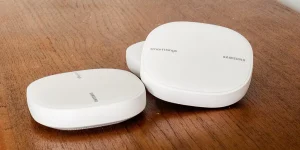Smart Doorbells: What They Are, How They Work, Applications, and Safe Usage

1. What is a Smart Doorbell?
A smart doorbell is an advanced doorbell system equipped with internet connectivity and smart features that enhance home security and convenience. Unlike traditional doorbells that only chime when pressed, smart doorbells come with features such as real-time video streaming, two-way communication, motion detection, and mobile app integration.
Types of Smart Doorbells
Smart doorbells are generally categorized into two main types:
- Wired Smart Doorbells: Connected directly to the home’s electrical system and existing chime box. These provide a reliable power source but may require professional installation.
- Wireless Smart Doorbells: Operate on battery power, making them easy to install and relocate, but they require periodic battery recharging or replacement.
Key Features and Benefits
- Live Video Feed: Allows homeowners to see who is at the door in real time through a mobile app.
- Two-Way Audio Communication: Enables conversation with visitors remotely.
- Motion Detection Alerts: Notifies users when movement is detected near the door.
- Cloud or Local Storage: Saves recorded footage for security and monitoring purposes.
- Smart Integration: Compatible with smart home ecosystems like Alexa, Google Assistant, and Apple HomeKit.
2. How Smart Doorbells Work
Smart doorbells function using a combination of hardware and software to provide security and convenience.
Main Components:
- Camera: Captures video footage of visitors and surroundings.
- Microphone & Speaker: Facilitates two-way communication.
- Motion Sensor: Detects movement and triggers alerts.
- Wi-Fi Module: Connects the doorbell to the internet and enables remote access via a mobile app.
- Chime Unit (Optional): Some models come with an indoor chime that sounds when someone rings the bell.
- Storage Unit (Cloud or Local): Saves video recordings for later viewing.
How It Works:
- When a visitor presses the doorbell button, a notification is sent to the homeowner’s smartphone.
- The built-in camera starts recording and live-streaming video.
- The homeowner can communicate with the visitor through the app using two-way audio.
- If motion is detected, the system sends alerts and records footage for security purposes.
3. Where Are Smart Doorbells Used?
Smart doorbells have widespread applications across different settings, enhancing security and convenience.
Home Security
- Provides 24/7 monitoring of the front door.
- Prevents package theft by alerting homeowners when deliveries arrive.
- Allows homeowners to screen visitors before opening the door.
Apartment Complexes & Offices
- Used in multi-unit buildings with shared security access.
- Employees can monitor visitor entry remotely.
Industrial and Commercial Use
- Installed in warehouses and business premises for security.
- Used in gated communities to verify visitor identity.
4. How to Use a Smart Doorbell Safely
While smart doorbells offer numerous benefits, proper setup and usage are essential for security and privacy.
Safety Tips:
- Secure Your Wi-Fi Network: Use a strong password and enable WPA3 encryption to prevent hacking.
- Regularly Update Firmware: Install updates to protect against vulnerabilities.
- Adjust Motion Sensitivity: Avoid false alerts by fine-tuning motion detection settings.
- Enable Two-Factor Authentication (2FA): Adds an extra layer of security to your smart doorbell account.
- Monitor Recorded Footage: Regularly check recordings to ensure they capture relevant events.
Privacy Considerations:
- Inform Visitors: Let guests know they are being recorded.
- Avoid Invasive Placement: Position the doorbell to focus on your property and not your neighbors’.
Conclusion
Smart doorbells are a valuable addition to any home or business, enhancing security, convenience, and control over front-door interactions. Understanding their functionality, applications, and safe usage ensures maximum benefits while protecting your privacy. By following proper security measures, homeowners can enjoy peace of mind knowing their property is well-monitored and protected.






